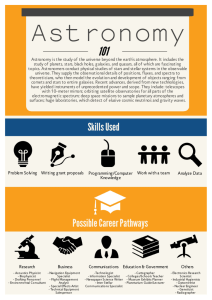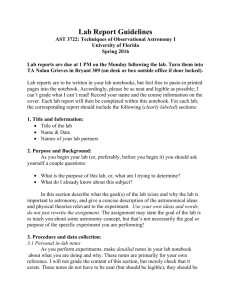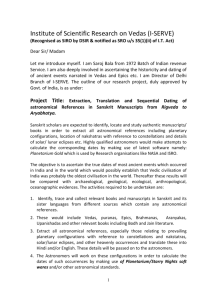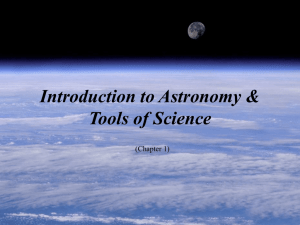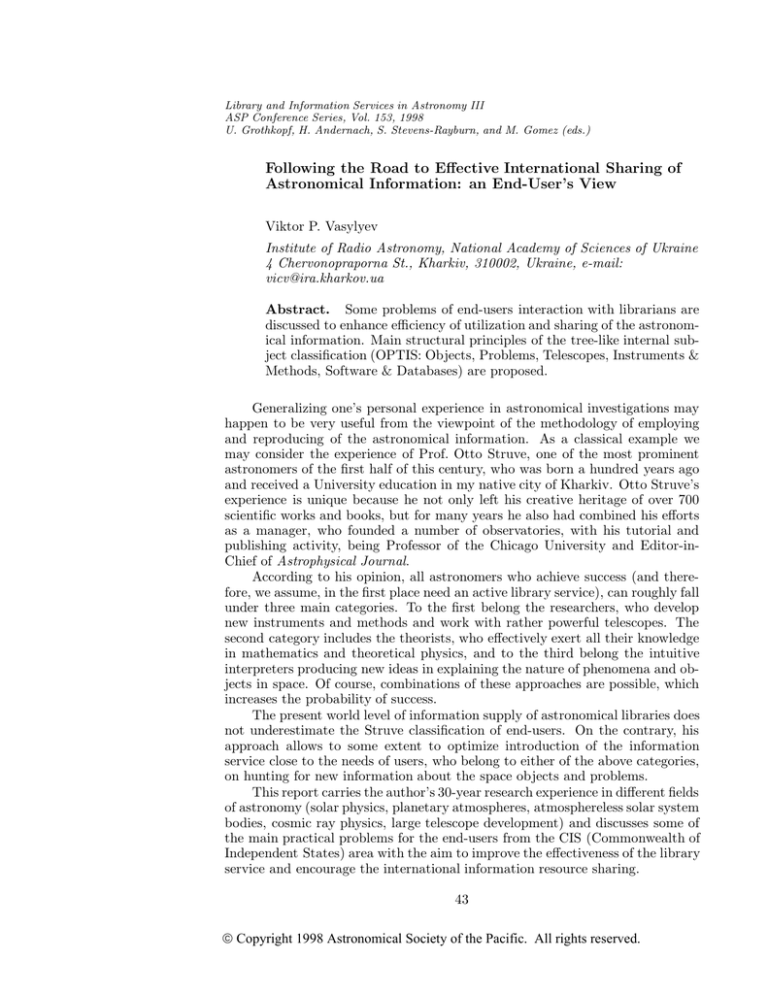
Library and Information Services in Astronomy III
ASP Conference Series, Vol. 153, 1998
U. Grothkopf, H. Andernach, S. Stevens-Rayburn, and M. Gomez (eds.)
Following the Road to Effective International Sharing of
Astronomical Information: an End-User’s View
Viktor P. Vasylyev
Institute of Radio Astronomy, National Academy of Sciences of Ukraine
4 Chervonopraporna St., Kharkiv, 310002, Ukraine, e-mail:
vicv@ira.kharkov.ua
Abstract. Some problems of end-users interaction with librarians are
discussed to enhance efficiency of utilization and sharing of the astronomical information. Main structural principles of the tree-like internal subject classification (OPTIS: Objects, Problems, Telescopes, Instruments &
Methods, Software & Databases) are proposed.
Generalizing one’s personal experience in astronomical investigations may
happen to be very useful from the viewpoint of the methodology of employing
and reproducing of the astronomical information. As a classical example we
may consider the experience of Prof. Otto Struve, one of the most prominent
astronomers of the first half of this century, who was born a hundred years ago
and received a University education in my native city of Kharkiv. Otto Struve’s
experience is unique because he not only left his creative heritage of over 700
scientific works and books, but for many years he also had combined his efforts
as a manager, who founded a number of observatories, with his tutorial and
publishing activity, being Professor of the Chicago University and Editor-inChief of Astrophysical Journal.
According to his opinion, all astronomers who achieve success (and therefore, we assume, in the first place need an active library service), can roughly fall
under three main categories. To the first belong the researchers, who develop
new instruments and methods and work with rather powerful telescopes. The
second category includes the theorists, who effectively exert all their knowledge
in mathematics and theoretical physics, and to the third belong the intuitive
interpreters producing new ideas in explaining the nature of phenomena and objects in space. Of course, combinations of these approaches are possible, which
increases the probability of success.
The present world level of information supply of astronomical libraries does
not underestimate the Struve classification of end-users. On the contrary, his
approach allows to some extent to optimize introduction of the information
service close to the needs of users, who belong to either of the above categories,
on hunting for new information about the space objects and problems.
This report carries the author’s 30-year research experience in different fields
of astronomy (solar physics, planetary atmospheres, atmosphereless solar system
bodies, cosmic ray physics, large telescope development) and discusses some of
the main practical problems for the end-users from the CIS (Commonwealth of
Independent States) area with the aim to improve the effectiveness of the library
service and encourage the international information resource sharing.
43
Copyright 1998 Astronomical Society of the Pacific. All rights reserved.
44
V. P. Vasylyev
Figure 1.
Let us consider a simplified interaction scheme “information-librarian-enduser”, shown in Figure 1. Obviously, the informational needs of the end-users
belonging to the afore-mentioned categories differ considerably, though each of
them taken separately can in general employ all accessible channels of information. As Figure 1 shows, the computer service, oral & poster service and own
searching activity can be identified as the main channels. Recently the on-line
computer service begins to play the leading part both in passive and interactive
modes. However, living in a rapidly changing information environment, they are
often thought to be poor searchers in a digital library (except for those operating
computers most closely), despite the fact that only they understand fairly well
which information they need and can evaluate its importance. In addition, all
this is affected by permanent time limitation and region-specific problems.
Cooperation of end-users with librarians has always been close and important. Under present conditions this cooperation becomes even more necessary
and professional, i.e. astronomers need more skills in searching for the required
information, while librarians have to learn more about the present astronomy.
Generally speaking, the required information can be obtained by the enduser himself. However, this strongly depends on the degree of its accessibility
Following the Road to Effective International Sharing of Information
Figure 2.
and abundance. In case the required publication is rather rare and aperiodic,
the difficulties in obtaining, say, the article or abstract’s texts may arise even
when “the entire power” of modern libraries is applied. Not so long ago such was
the case encountered by me and a very qualified librarian in the library of the
well-known American University while searching for an abstract fresh-published
in the Supplement Series of Annales Geophysicae. Therefore, the end-users of
all the above activity-categories are interested in efficient assistance of highlyqualified librarians, who accumulate their preceding experience in retrieving
such kind of information. How to make this assistance more convenient, easily
accessible and useful for the end-users? How to neutralize the informational
shock, caused by the avalanche of information, and to streamline this avalanche
into the identified channels? Can we find a universal, effective and convenient
language for communication between the keepers/distributors of the information
and those who need it as the breath of life to conduct their research? These
questions are extremely interesting for all of us, both for the librarians and for
the end-users. Besides the well-known and vastly used approaches and manners
in interaction between the end-users and the librarians, we may propose as
well to develop a “working” (home-library) subject classification of astronomical
information.
This classification employs the idea of a “tree” of the International Patent
Classification and is shown schematically in Figures 2 and 3.
Its main advantages are: simplicity, clearness, usage convenience and capability for improvement. In order to classify the publication into this or that
45
46
V. P. Vasylyev
O B J E C T S
2
SOLAR
1 SYSTEM
3 GALAXIES
O2a
SUN
O1a
GALAXY
O2a 08/02 -RS CVn-type
stars with observed R¸
emission
O1e
O1e
01
/
MAIN B.
ASTER.
O1e 02/
COUPER
B. ASTER.
O1e 03/
5 UNIVERSE
EXAMPLES:
O1b PLANETS O2b
O1c SATELLIT. O2c
O1d COMETS O2d
ASTER.
O2e
N-EARTH
ASTER.
EXTRA-GAL.
OBJECTS
4
O3d 03/05 - radioemitting
interacting galaxies with high
redshifts
O1 - solar system as a whole
S-TYPE
ASTER.
Figure 3.
class, subclass, group or subgroup, it is enough for the librarian to look through
the abstract. In the frames of the suggested subject classification the librarian
will be able to initially treat the information, in particular: a) perform search
and extraction; b) make a selection according to the end-user’s interest-section,
foreseeing further possible interests, and c) ensure an effective home-library presentation, speaking to the users in their own language. Here it is important to
note one principal nuance and beware of a euphoria, which may happen while
analyzing the possibility of employment of digitized astronomical information.
The present state of affairs still can be called transitive from the traditional
methods of informational service to the new ones, which are wholly empowered by computers and the Internet. There is an enormous abyss between the
Internet-era astronomical information and information of the whole preceding
period of developing the fundamental sciences. Roughly speaking, most scientific articles and books, as the main source of knowledge about the Universe,
remain to be available on paper. Using their electronic version is utmostly inconvenient and, probably, they will never be good for this. So far as simple
scanning will not solve the problem of convenient information usage, this kind
of information carries and will for long carry the basic character, being extremely
needed, say, for interpretation of the obtained results, as well as for quality in
education of young astronomers. The author will try to demonstrate this using
the methodological scheme of astronomical research – see Figure 4. Astronomy
was and remains mainly an observational science, therefore everything, as a rule,
begins from the answer to the question “What is observed?” However, in order to answer the other two (more complex!) questions “How does it actually
Following the Road to Effective International Sharing of Information
Figure 4.
occur?” and “Why so and not otherwise?” the Internet-era information is not
sufficient. Only upon having the answers to the last two questions we may consider the research as relatively accomplished and insert the received data into
a live mosaic of our knowledge about the Universe. By the way, for most of
the astronomical problems not only the third, but the second question as well,
remains uncertain. We may draw such an analogy: despite the spectacular discoveries, obtained with modern space technology, the astronomers cannot do
without the knowledge accumulated and filed in books and journal articles in
astronomy, physics, mathematics, chemistry during some previous decades and
without modern observational data, obtained with ground-based telescopes. My
personal experience and that of my colleagues shows that we have merely never
founded anything important in the digital area, especially in searching for a
non-traditional approach to solving an astronomical problem, both for the current investigations and for the University teaching. In other words, until now,
being in the frames of computer service only, we have to swim on the surface
of the ocean of information, though it is vast enough and contains a concentric knowledge of maximum novelty. In general, from the end-user’s viewpoint
while creating the library service it should not be forgotten that in astronomy,
like in any other fundamental science, the part of uninterrupted continuity of
information, when the latest inventions and routine data are merely new parts
of an already erected building which cannot be pulled down and built anew is
very important. This gives rise to the necessity of more active using of good old
methods of library service.
47
48
V. P. Vasylyev
The mentioned peculiarities and difficulties in using the astronomical information by the end-users typical both for traditional and digital forms aggravate
in less-developed regions. This occurs mainly due to the reason that these countries have worse technical and communication facilities. Therefore, despite rapid
spread of local nets and recent accessibility of the Internet, the opportunity of
employing the on-line computer service is still insufficient. As a kind of alternative capable to partially remove these difficulties we may regard propagation
of astronomy information through high-density carriers (especially CDs). This
permits to rapidly distribute the articles, databases, software, etc. using local
nets thus providing the required information sharing.
In this sense a very important part could be played by the international
cooperation between astronomers as well as between librarians. In addition to
the powerful means of information retrieval already available, there is a pressing
need for effective but simpler methods for the analysis and compression of both
texts and graphics and these methods should be made easily available to nonprofessional programmers.
Acknowledgments.
The author extends his profound gratitude to
Dr. Sergei V. Vasylyev for creative discussions.


